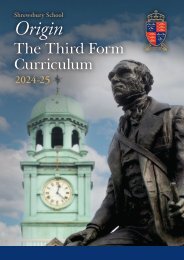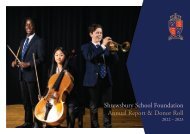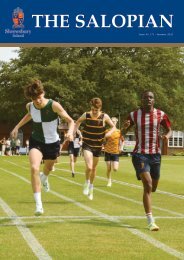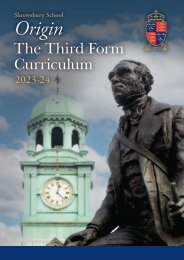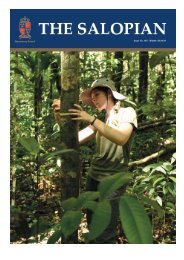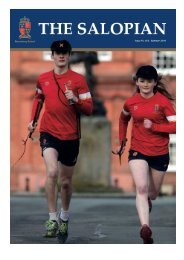The Salopian no. 157 - Winter 2015
You also want an ePaper? Increase the reach of your titles
YUMPU automatically turns print PDFs into web optimized ePapers that Google loves.
24<br />
SCHOOL NEWS<br />
Old <strong>Salopian</strong>s in World War 1<br />
Each week on the School website we publish the names and short biographies of the Old <strong>Salopian</strong>s killed<br />
100 years ago during the First World War, and these are included in the weekly eNewsletter sent to<br />
all staff, pupils and current parents. This is part of a four-year project in collaboration with St Chad’s<br />
Church in Shrewsbury. A short Service of Remembrance is held at St Chad’s every Wednesday at 5pm,<br />
when the OS names are included among others from Shropshire whose<br />
100th anniversary of death falls that week.<br />
<strong>The</strong> following Old <strong>Salopian</strong>s will be<br />
remembered at School and in St Chad’s<br />
between January and June <strong>2015</strong>.<br />
Corporal Harold Gar<strong>no</strong>ck Potts,<br />
M2/098045, Army Service Corps.<br />
Churchill’s, left in 1901 and was<br />
admitted solicitor to a practice in<br />
Broseley, Salop. Died in the United<br />
Kingdom, 6th February 1916, aged 32.<br />
Buried at Broseley Cemetery, England.<br />
Grave C.E. I. 433.<br />
Lieutenant John Frith Sidebotham,<br />
6th Bn. King’s Shropshire Light<br />
Infantry<br />
School House, Praepostor, Cricket XI<br />
and Fives VI, left in 1910 and was on<br />
the staff of Messrs. James Greaves,<br />
East India Merchants, of Manchester<br />
and Bombay. He went up to Hertford<br />
College, Oxford and twice captained<br />
the lacrosse team against Cambridge.<br />
He enlisted in 5th K.S.L.I. and was<br />
gazetted to the 6th in January 1916.<br />
<strong>The</strong> <strong>Salopian</strong> remembers him as “one<br />
of the most modest boys and men.<br />
But his friends here and the staff of<br />
the School House and the boys at the<br />
Mission in Liverpool* knew his value<br />
better than he knew himself”. He was<br />
“a very loyal <strong>Salopian</strong>, who taught,<br />
without k<strong>no</strong>wing it, the power and the<br />
ho<strong>no</strong>ur of an entirely unselfish life”.<br />
Killed in action by a shell explosion<br />
during a bombardment in Belgium,<br />
12th February 1916, aged 24. Buried<br />
at White House Cemetery, St. Jean-Les-<br />
Ypres, Belgium. Grave III. Q. 4.<br />
* Shrewsbury House, inaugurated only<br />
a few years earlier by the Revd Digby<br />
Kittermaster<br />
Captain John Arthur Walker,<br />
10th Bn. Royal Welsh Fusiliers<br />
Moser’s, “a quiet, u<strong>no</strong>btrusive boy”, left<br />
in 1909 for Trinity Hall, Cambridge, and<br />
at the outbreak of war at once joined<br />
the O.T.C; he was gazetted November<br />
1914 and promoted Captain July 1915.<br />
His Commanding Officer said, “He<br />
was beloved by both officers and men.<br />
His was one of those rare natures<br />
that one could <strong>no</strong>t help loving”. His<br />
Chaplin also wrote, “As a friend his<br />
loss is inestimable and as a soldier he<br />
was a born leader of men the memory<br />
of whom should ever be a source of<br />
inspiration to all who knew him”.<br />
Killed in action by the explosion of<br />
a shell while encouraging his men in<br />
Belgium, 19th February 1916, aged 24.<br />
Buried at Reninghelst New Military<br />
Cemetery, Belgium. Grave I. B. 8.<br />
Lieutenant Gilbert Kingsley Lloyd,<br />
2nd Bn. King’s Shropshire Light<br />
Infantry<br />
School House, left in 1889. Served<br />
through the South African War with<br />
the Shropshire Imperial Yeomanry as<br />
Lance-Corporal in charge of a machine<br />
gun (Medal, 3 clasps) before going<br />
to Saskatchewan, N.W.T. Canada.<br />
Commissioned into the K.S.L.I. and<br />
gazetted to 2nd Lieutenant, he saw<br />
much fighting in France. Died in<br />
Salonika, Greece, of appendicitis, 21st<br />
February 1916, aged 35. Buried at<br />
Mikra British Cemetery, Kalamaria,<br />
Greece. Grave 1804.<br />
Captain Alfred Henry Parsons,<br />
2nd Bn. 9th Gurkha Rifles.<br />
School House, left in 1900. B.A., Keble<br />
College, Oxford. Present with his<br />
Regiment at Festubert and Givenchy<br />
Wood. He was severely wounded<br />
in January but returned to his duty;<br />
and then was killed in action in<br />
Mesopotamia 8th March 1916, aged 33.<br />
Remembered on Basra Memorial, Iraq.<br />
Panel 51.<br />
Second Lieutenant Richard Arthur<br />
Maurice Lutener, 6th Bn. King’s<br />
Shropshire Light Infantry<br />
School House, left in 1914 for Keble<br />
College, Oxford. Commissioned in<br />
December 1914, he went to the front in<br />
July 1915 and was shot by a sniper in<br />
Belgium, 6th April 1916, aged 20.<br />
Buried at Essex Farm Cemetery,<br />
Belgium. Grave I. B. 4.<br />
Lieutenant Ar<strong>no</strong>ld Mathews,<br />
14th Bn. Cheshire Regiment.<br />
Baker’s (<strong>no</strong>w Severn Hill), Huntsman,<br />
Football XI, one of the best runners<br />
the school has seen and Head of<br />
the Science Side. He left in 1913 for<br />
Corpus Christi College, Cambridge with<br />
a science scholarship and was there<br />
awarded the Careswell Scholarship.<br />
Along with many other OS he enlisted<br />
in the ranks of the 5th Bn. K.S.L.I.<br />
but after a few weeks he obtained<br />
a commission to the 14th Cheshires.<br />
“Unassuming and quite regardless of<br />
himself, he gained the sincere esteem<br />
of his contemporaries” – <strong>The</strong> <strong>Salopian</strong>.<br />
He took part in the fighting on the<br />
Tigris front on 5th and 9th April<br />
and died of wounds received, in<br />
Mesopotamia, 14th April 1916, aged 21.<br />
Remembered on Basra Memorial, Iraq.<br />
Panel 14 and 62.<br />
Lieutenant David Henry Carmichael<br />
Monro, 29th Bn. Canadian Infantry<br />
(British Columbia Regiment)<br />
School House, left in 1903 for Oriel<br />
College, Oxford. He was called to the<br />
Bar in Lincoln’s Inn, and then joined<br />
the Nigerian Civil Service. Retiring<br />
after three years due to ill health, he<br />
then joined the Canadian Army in<br />
1914, going with them to the front in<br />
September 1915. Died of wounds in<br />
Belgium, 4th May 1916, aged 31.<br />
Buried at Reninghelst New Military<br />
Cemetery, Belgium. Grave I. B. 18.<br />
Captain Victor Eustace Rey<strong>no</strong>lds,<br />
10th Bn. West Yorkshire Regiment<br />
(Prince of Wales’s Own)<br />
School House, left in 1896 to enter<br />
Slade School of Art and then worked<br />
for some years painting in Paris and<br />
Florence. He took the post of Art<br />
Master at Haberdashers’ Aske’s and<br />
Life Master at evening classes in<br />
Lambeth Art School. He enlisted on the<br />
outbreak of war and obtained his 2nd<br />
Lieutenancy in May 1915, gaining rapid<br />
promotion. “He married a daughter of<br />
the Late Frank Holl, R.A., and leaves a<br />
little son” – <strong>The</strong> Times. Killed in action<br />
in France 4th May 1916 aged 36.<br />
Buried at Cite Bonjean Military Cemetery,<br />
Armentieres, France. Grave IX. G. 2.<br />
Second Lieutenant Edward Pitcairn<br />
Jones, 5th Bn. attd. 9th Bn.<br />
Rifle Brigade.<br />
School House, Head of House, left in<br />
1915; exhibitioner to Oriel College,<br />
Oxford.



